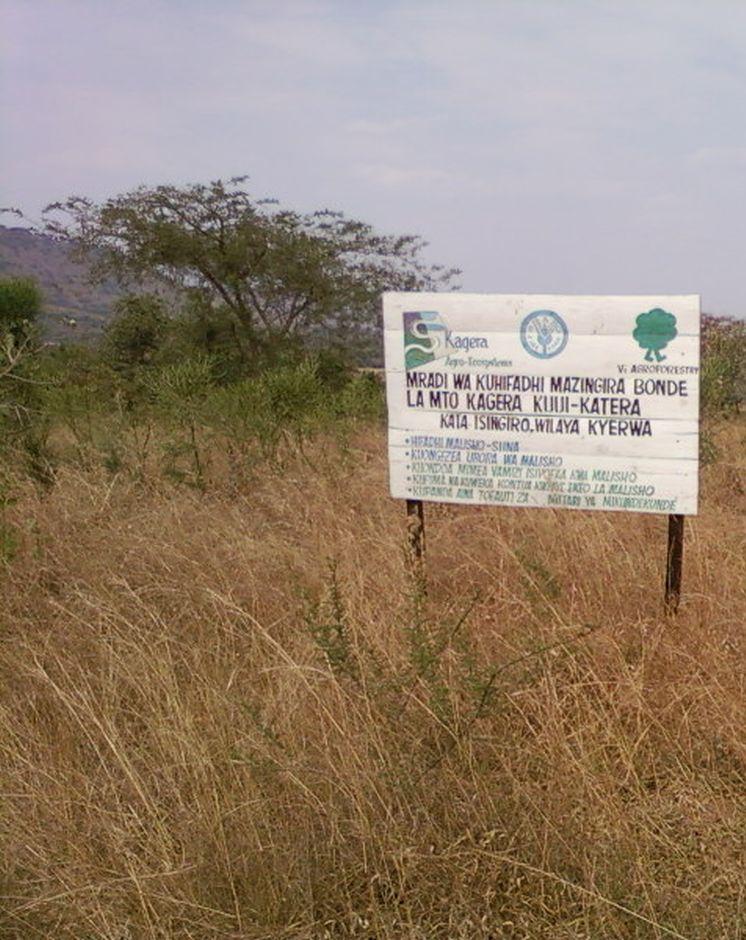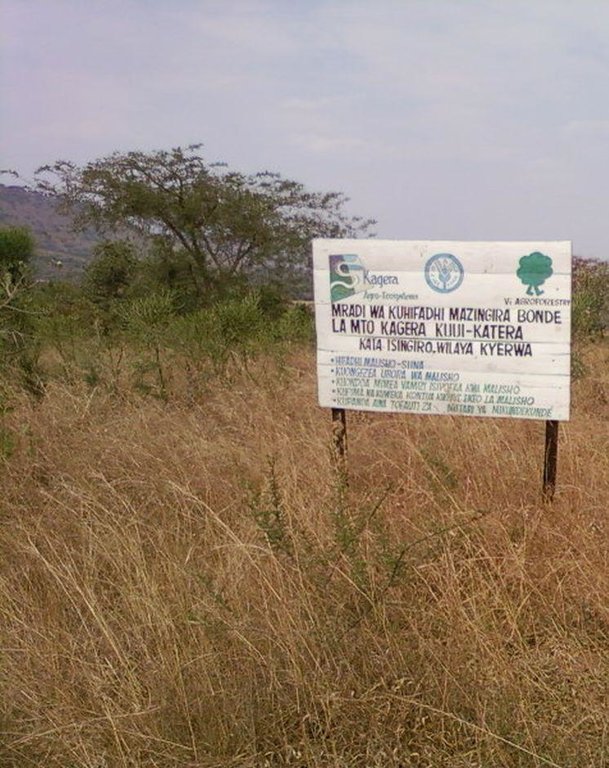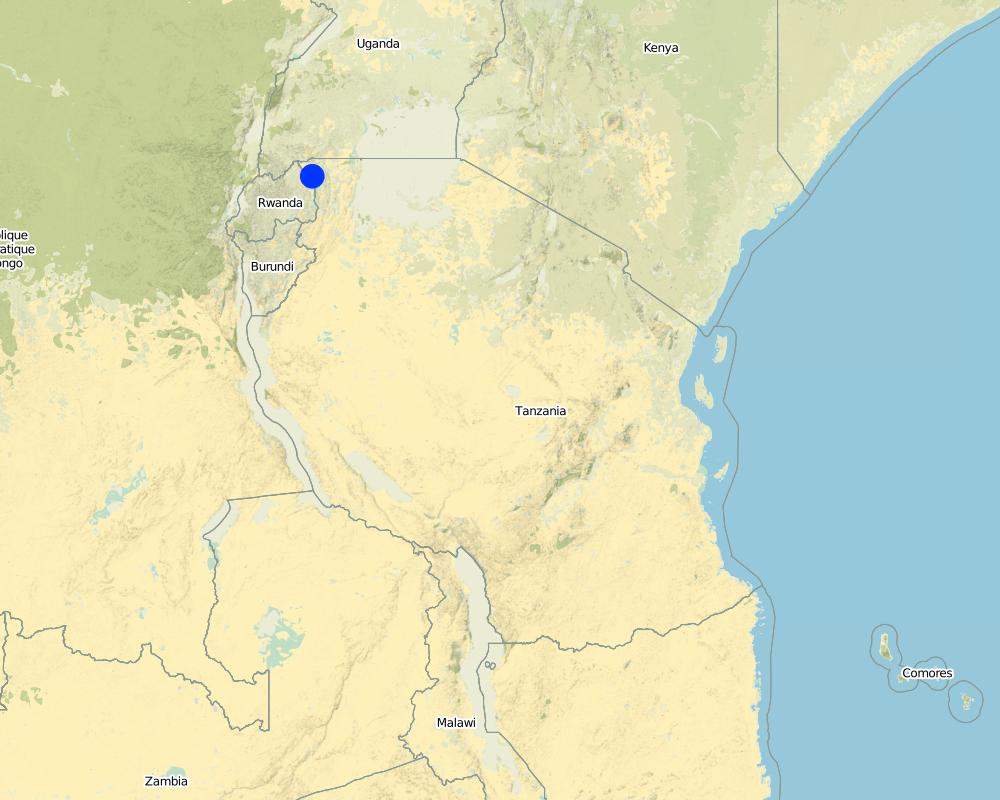Range enclosures [แทนซาเนีย]
- ผู้สร้างสรรค์:
- การอัพเดท:
- ผู้รวบรวม: Godfrey Baraba
- ผู้เรียบเรียง: –
- ผู้ตรวจสอบ: Fabian Ottiger
Hifadhi ya malisho
technologies_1612 - แทนซาเนีย
ดูส่วนย่อย
ขยายทั้งหมด ย่อทั้งหมด1. ข้อมูลทั่วไป
1.2 รายละเอียดที่ติดต่อได้ของผู้รวบรวมและองค์กรที่เกี่ยวข้องในการประเมินและการจัดเตรียมทำเอกสารของเทคโนโลยี
ผู้เชี่ยวชาญ SLM:
Pesha Wambura
Kyerwa District Council
แทนซาเนีย
ผู้เชี่ยวชาญ SLM:
Bubelwa Allani
Misenyi District Council
แทนซาเนีย
ชื่อขององค์กรซึ่งอำนวยความสะดวกในการทำเอกสารหรือการประเมินเทคโนโลยี (ถ้าเกี่ยวข้อง)
Missenyi District Council (Missenyi District Council) - แทนซาเนียชื่อขององค์กรซึ่งอำนวยความสะดวกในการทำเอกสารหรือการประเมินเทคโนโลยี (ถ้าเกี่ยวข้อง)
Bukoba district council (Bukoba district council) - แทนซาเนียชื่อขององค์กรซึ่งอำนวยความสะดวกในการทำเอกสารหรือการประเมินเทคโนโลยี (ถ้าเกี่ยวข้อง)
Kyerwa District Council - แทนซาเนีย1.3 เงื่อนไขการใช้ข้อมูลที่ได้บันทึกผ่านทาง WOCAT
วันที่เก็บรวบรวมข้อมูล(ภาคสนาม) :
25/07/2014
ผู้รวบรวมและวิทยากรหลักยอมรับเงื่อนไขเกี่ยวกับการใช้ข้อมูลที่ถูกบันทึกผ่านทาง WOCAT:
ใช่
1.4 การเปิดเผยเรื่องความยั่งยืนของเทคโนโลยีที่ได้อธิบายไว้
เทคโนโลยีที่ได้อธิบายไว้นี้เป็นปัญหาของความเสื่อมโทรมโทรมของที่ดินหรือไม่ จึงไม่ได้รับการยอมรับว่าเป็นเทคโนโลยีเพื่อการจัดการที่ดินอย่างยั่งยืน:
ไม่ใช่
2. การอธิบายลักษณะของเทคโนโลยี SLM
2.1 การอธิบายแบบสั้น ๆ ของเทคโนโลยี
คำจำกัดความของเทคโนโลยี:
Is the restriction, reseedling of desmodium decoloratum, stylothensis hamata and Stilozobium spps in the demarcated overgrazed land.
2.2 การอธิบายแบบละเอียดของเทคโนโลยี
คำอธิบาย:
The grazing land enclosure combined with quality pastures’ reseeding is the identification and demarcation of the degraded grazing land, reseeding palatable grass species and legumes with application of rotational grazing system. The technology is applied on the grazing land in the tropics, sub humid, gentle undulating upland, seasonal swamps to ensure SaLM with increased quantity and quality of pasture production. The land cultivation is done manually using hand hoes, in the mixed production system. The land ownership is communal and the land use right is organized (grazing land is demarcated) for all livestock keepers to graze their livestock. The establishment procedures includes planting of Euphobia spps along the borders, reseeding palatable grasses spps on the bare spots, plough and drill legume seeds intergraded with grasses. The maintenance procedures require range patrol, paddocks (fences and roads) maintenance. The average cost to establish one hector of the technology is US$ 122.11 while the maintenance of one hector is US$ 41.72 the technology was introduced by Kagera TAMP in 2012 using FFS methodology. Hay making is considered to be supportive technology that can add effectiveness to the main technology.
Purpose of the Technology: The major purpose is to restore soil vegetative cover, increase biomass, increase soil nutrient cycling, reduce soil moisture stress and diversify pasture species, for recommended carrying capacity attainments.
Establishment / maintenance activities and inputs: The establishment activities include; first identification and demarcation of degraded grazing land done in June. Second is broadcasting improved pasture seeds (Chloris gayana and Congo signal) done in late August. Third is establishment of live fence (planting Euphobia spps, sisal seedling and mikwatango) done in September. Fourth is cultivation of bare land spots and drill legume seeds (Stylosthensis hamata, centocema pubences etc) or plant improved legume cuttings (Desmodium coloratum). The maintenance activities includes; first weeding invasive species (sida accuta, Duratura stromonium etc) done manually using hand hoes and machete in June and January. Second is fire break cleaning done manually using hand hoes in May and December. Last but not least to importance is range patrol done routinely.
Natural / human environment: The human environments includes wealthy stutus as 13% poor land user, 50% average land users and 37% rich land users owning the land ownership is communal. The land cultivation is done manually using hand hoes. The production system is mixed in the sense that, live cull cows and steers are for sale while small ruminants and milk are for both domestic consumption and sales of excess.
2.3 รูปภาพของเทคโนโลยี
2.5 ประเทศภูมิภาค หรือสถานที่ตั้งที่เทคโนโลยีได้นำไปใช้และได้รับการครอบคลุมโดยการประเมินนี้
ประเทศ:
แทนซาเนีย
ภูมิภาค/รัฐ/จังหวัด:
Tanzania
ข้อมูลจำเพาะเพิ่มเติมของสถานที่ตั้ง :
Kyerwa
Map
×2.6 วันที่การดำเนินการ
ถ้าไม่รู้ปีที่แน่นอน ให้ระบุวันที่โดยประมาณ:
- น้อยกว่า 10 ปี (ไม่นานนี้)
2.7 คำแนะนำของเทคโนโลยี
ให้ระบุว่าเทคโนโลยีถูกแนะนำเข้ามาอย่างไร:
- ทางโครงการหรือจากภายนอก
ความคิดเห็น (ประเภทของโครงการ เป็นต้น) :
FFS trained on land conservations in Katera hifadi ya malisho group using pasture improvemnt as indicor crop.
3. การจัดประเภทของเทคโนโลยี SLM
3.1 วัตถุประสงค์หลักของเทคโนโลยี
- ลด ป้องกัน ฟื้นฟู การเสื่อมโทรมของที่ดิน
- รักษาสภาพหรือปรับปรุงความหลากหลายทางชีวภาพ
3.2 ประเภทของการใช้ที่ดินในปัจจุบันที่ได้นำเทคโนโลยีไปใช้

ทุ่งหญ้าเลี้ยงสัตว์

การใช้ที่ดินแบบผสมผสาน (รวมถึงวนเกษตร)
- การปลูกพืชร่วมกับปศุสัตว์ (Agro-pastoralism)
ผลิตภัณฑ์หลักหรือบริการ:
Bovine, caprine and ovine
แสดงความคิดเห็น:
Major land use problems (compiler’s opinion): The major land use problem related to soil, water and vegetation in the area was loss of palatable spps, reduced vegetative cover and ....
Major land use problems (land users’ perception): The major land use problem was poor/ inadequate pastures.
Mixed: (eg agro-pastoralism, silvo-pastoralism): bovine, caprine and ovine
3.3 ข้อมูลเพิ่มเติมเกี่ยวกับการใช้ที่ดิน
การใช้น้ำของที่ดินที่มีการใช้เทคโนโลยีอยู่:
- จากน้ำฝน
แสดงความคิดเห็น:
Water supply: Also post-flooding
จำนวนของฤดูเพาะปลูกต่อปี:
- 2
ระบุ:
Longest growing period in days: 120, Longest growing period from month to month: November to February Second longest growing period in days: 90 Second longest growing period from month to month: March to May
ความหนาแน่นของปศุสัตว์ (ถ้าเกี่ยวข้อง):
> 100 LU /km2
3.4 กลุ่ม SLM ที่ตรงกับเทคโนโลยีนี้
- การปิดล้อมพื้นที่ (หยุดการใช้ประโยชน์ สนับสนุนการฟื้นฟู)
3.5 กระจายตัวของเทคโนโลยี
ระบุการกระจายตัวของเทคโนโลยี:
- กระจายไปอย่างสม่ำเสมอในพื้นที่
ถ้าหากว่าเทคโนโลยีได้มีการกระจายออกไปอย่างสม่ำเสมอในพื้นที่ ให้ระบุปริมาณพื้นที่ที่ได้รับการครอบคลุมถึง:
- < 0.1 ตร.กม.(10 เฮกตาร์)
แสดงความคิดเห็น:
Total area covered by the SLM Technology is 0.03 km2.
Communal overgrazed portioned as site for FFS for technology training.
3.6 มาตรการ SLM ที่ประกอบกันเป็นเทคโนโลยี

มาตรการอนุรักษ์ด้วยการจัดการ
- M2: การเปลี่ยนแปลงของการจัดการหรือระดับความเข้มข้น
- M5: การควบคุมหรือการเปลี่ยนแปลงขององค์ประกอบของชนิดพันธุ์
3.7 รูปแบบหลักของการเสื่อมโทรมของที่ดินที่ได้รับการแก้ไขโดยเทคโนโลยี

การกัดกร่อนของดินโดยน้ำ
- Wt (Loss of topsoil): การสูญเสียดินชั้นบนหรือการกัดกร่อนที่ผิวดิน

การเสื่อมโทรมของดินทางด้านกายภาพ
- Pc (Compaction): การอัดแน่น

การเสื่อมโทรมของดินทางด้านชีวภาพ
- Bc (Reduction of vegetation cover): การลดลงของจำนวนพืชที่ปกคลุมดิน
- Bq (Quantity/biomass decline): การลดลงของปริมาณหรือมวลชีวภาพ
- Bf (Detrimenta leffects of fires): ผลเสียหายจากไฟ
- Bs (Quality and species composition): องค์ประกอบหรือความหลากหลายทางคุณภาพและชนิดพันธุ์ลดลง
แสดงความคิดเห็น:
Main causes of degradation: overgrazing (Livestock holding density in the area is 116 per square km.), change of seasonal rainfall (dry spel tends to prolong in long rain seasons.), droughts (the area experiences a long drought period.), land tenure (difficult to control grazing regimes in the communal owned land.), governance / institutional (leizure fair on grazing land control resulted into cattle influxes in the area.)
3.8 การป้องกัน การลดลง หรือการฟื้นฟูความเสื่อมโทรมของที่ดิน
ระบุเป้าหมายของเทคโนโลยีกับความเสื่อมโทรมของที่ดิน:
- ป้องกันความเสื่อมโทรมของที่ดิน
- ลดความเสื่อมโทรมของดิน
4. ข้อมูลจำเพาะด้านเทคนิค กิจกรรมการนำไปปฏิบัติใช้ ปัจจัยนำเข้า และค่าใช้จ่าย
4.2 ข้อมูลจำเพาะด้านเทคนิคและการอธิบายแบบแปลนทางเทคนิค
Technical knowledge required for field staff / advisors: low (Basic principles of pasture management is taught at colleges.)
Technical knowledge required for land users: moderate (Leguminous spps re seedlings requires new knowledge.)
Main technical functions: improvement of ground cover, increase in organic matter, increase in nutrient availability (supply, recycling,…), promotion of vegetation species and varieties (quality, eg palatable fodder), control of fires
Secondary technical functions: increase / maintain water stored in soil, increase of biomass (quantity)
Change of land use practices / intensity level: Instead of continuous grazing, rotational grazing is recommended to reduces the frequencies of livestock trumping the land.
Control / change of species composition: In the overgrazed land palatable spps had lost while unpalatable spps dominated. Furthermore, legumes for quality improvement had disappeared.
4.3 ข้อมูลทั่วไปเกี่ยวกับการคำนวณปัจจัยนำเข้าและค่าใช้จ่าย
อื่นๆ หรือสกุลเงินประจำชาติ (ระบุ):
Tshs
ระบุอัตราแลกเปลี่ยนจากดอลลาร์สหรัฐเป็นสกุลเงินท้องถิ่น (ถ้าเกี่ยวข้อง) คือ 1 เหรียญสหรัฐ =:
1700.0
ระบุค่าเฉลี่ยของค่าจ้างในการจ้างแรงงานต่อวัน:
1.88
4.4 กิจกรรมเพื่อการจัดตั้ง
| กิจกรรม | ประเภทของมาตรการ | ช่วงเวลาดำเนินการ | |
|---|---|---|---|
| 1. | To identify the degraded grazing land. | ด้วยการจัดการ | |
| 2. | To plant Euphobia triculi | ด้วยการจัดการ | |
| 3. | To plat sisal | ด้วยการจัดการ | |
| 4. | To plat elephant grass | ด้วยการจัดการ | |
| 5. | To reseed legumes | ด้วยการจัดการ | |
| 6. | To clear fire break along the demarcated borders. | ด้วยการจัดการ |
4.5 ค่าใช้จ่ายของปัจจัยนำเข้าที่จำเป็นสำหรับการจัดตั้ง
| ปัจจัยนำเข้า | หน่วย | ปริมาณ | ค่าใช้จ่ายต่อหน่วย | ค่าใช้จ่ายทั้งหมดต่อปัจจัยนำเข้า | %ของค่าใช้จ่ายที่ก่อให้เกิดขึ้นโดยผู้ใช้ที่ดิน | |
|---|---|---|---|---|---|---|
| แรงงาน | Labour | ha | 1.0 | 13.8 | 13.8 | |
| วัสดุด้านพืช | Seeds | ha | 1.0 | 119.02 | 119.02 | |
| วัสดุด้านพืช | Seedlings | ha | 1.0 | 3.09 | 3.09 | |
| ค่าใช้จ่ายทั้งหมดของการจัดตั้งเทคโนโลยี | 135.91 | |||||
4.6 การบำรุงรักษาสภาพหรือกิจกรรมที่เกิดขึ้นเป็นประจำ
| กิจกรรม | ประเภทของมาตรการ | ช่วงระยะเวลา/ความถี่ | |
|---|---|---|---|
| 1. | To remove invasive spps (shrubs/weeds) | ด้วยการจัดการ | |
| 2. | To clean the fire break | ด้วยการจัดการ | June and December |
4.7 ค่าใช้จ่ายของปัจจัยนำเข้าและกิจกรรมที่เกิดขึ้นเป็นประจำที่ต้องการการบำรุงรักษา (ต่อปี)
| ปัจจัยนำเข้า | หน่วย | ปริมาณ | ค่าใช้จ่ายต่อหน่วย | ค่าใช้จ่ายทั้งหมดต่อปัจจัยนำเข้า | %ของค่าใช้จ่ายที่ก่อให้เกิดขึ้นโดยผู้ใช้ที่ดิน | |
|---|---|---|---|---|---|---|
| แรงงาน | Labour | ha | 1.0 | 41.73 | 41.73 | 100.0 |
| ค่าใช้จ่ายทั้งหมดของการบำรุงรักษาสภาพเทคโนโลยี | 41.73 | |||||
5. สิ่งแวดล้อมทางธรรมชาติและของมนุษย์
5.1 ภูมิอากาศ
ฝนประจำปี
- < 250 ม.ม.
- 251-500 ม.ม.
- 501-750 ม.ม.
- 751-1,000 ม.ม.
- 1,001-1,500 ม.ม.
- 1,501-2,000 ม.ม.
- 2,001-3,000 ม.ม.
- 3,001-4,000 ม.ม.
- > 4,000 ม.ม.
ข้อมูลจำเพาะ/ความคิดเห็นเรื่องปริมาณน้ำฝน:
800mm bimodol (march to May and November to January)
เขตภูมิอากาศเกษตร
- กึ่งชุ่มชื้น
Thermal climate class: tropics. All months has a temperature above 18°C. LGP is 180 to 210 days
5.2 สภาพภูมิประเทศ
ค่าเฉลี่ยความลาดชัน:
- ราบเรียบ (0-2%)
- ลาดที่ไม่ชัน (3-5%)
- ปานกลาง (6-10%)
- เป็นลูกคลื่น (11-15%)
- เป็นเนิน (16-30%)
- ชัน (31-60%)
- ชันมาก (>60%)
ธรณีสัณฐาน:
- ที่ราบสูง/ที่ราบ
- สันเขา
- ไหล่เขา
- ไหล่เนินเขา
- ตีนเนิน
- หุบเขา
ระดับความสูง:
- 0-100 เมตร
- 101-500 เมตร
- 501-1,000 เมตร
- 1,001-1,500 เมตร
- 1,501-2,000 เมตร
- 2,001-2,500 เมตร
- 2,501-3,000 เมตร
- 3,001-4,000 เมตร
- > 4,000 เมตร
ความคิดเห็นและข้อมูลจำเพาะเพิ่มเติมเรื่องสภาพภูมิประเทศ:
Landforms: Footslopes (ranked 1, UP), hillsopes (MS) and mountain slopes (EP, both ranked 2)
Slopes on average: Gentle (bordering the valley) and moderate (bordering the hill slopes)
5.3 ดิน
ค่าเฉลี่ยความลึกของดิน:
- ตื้นมาก (0-20 ซ.ม.)
- ตื้น (21-50 ซ.ม.)
- ลึกปานกลาง (51-80 ซ.ม.)
- ลึก (81-120 ซ.ม.)
- ลึกมาก (>120 ซ.ม.)
เนื้อดิน (ดินชั้นบน):
- ปานกลาง (ดินร่วน ทรายแป้ง)
อินทรียวัตถุในดิน:
- ต่ำ (<1%)
(ถ้ามี) ให้แนบคำอธิบายเรื่องดินแบบเต็มหรือระบุข้อมูลที่มีอยู่ เช่น ชนิดของดิน ค่า pH ของดินหรือความเป็นกรดของดิน ความสามารถในการแลกเปลี่ยนประจุบวก ไนโตรเจน ความเค็ม เป็นต้น:
Soil depth on average: Shallow (laying over ironstone gravel)
Soil texture: Medium (friable redish brown to brown, with fine to coarse sand)
Soil fertility: Low
Topsoil organic matter: Low (bare spots dominated)
Soil drainage/infiltration: Medium
Soil water storage capacity: Low
5.4 ความเป็นประโยชน์และคุณภาพของน้ำ
ระดับน้ำใต้ดิน:
> 50 เมตร
น้ำไหลบ่าที่ผิวดิน:
ดี
คุณภาพน้ำ (ที่ยังไม่ได้บำบัด):
เป็นน้ำเพื่อการดื่มที่ดี
ความคิดเห็นและข้อมูลจำเพาะเพิ่มเติมเรื่องคุณภาพและปริมาณน้ำ:
Availability of surface water: Good (the range borders lake Kagenyi)
Water quality (untreated): Good drinking water (available gravity tape water from .....sources)
5.5 ความหลากหลายทางชีวภาพ
ความหลากหลายทางชนิดพันธุ์:
- ต่ำ
ความคิดเห็นและข้อมูลจำเพาะเพิ่มเติมของความหลากหลายทางชีวภาพ:
Dominated bare spots and dry soils.
5.6 ลักษณะของผู้ใช้ที่ดินที่นำเทคโนโลยีไปปฏิบัติใช้
รายได้ที่มาจากนอกฟาร์ม:
- < 10% ของรายได้ทั้งหมด
เป็นรายบุคคล/ครัวเรือน:
- กลุ่ม/ชุมชน
เพศ:
- หญิง
- ชาย
ระบุลักษณะอื่นๆที่เกี่ยวข้องของผู้ใช้ที่ดิน:
Land users applying the Technology are mainly common / average land users
Relative level of wealth: rich, average, poor
37% of the land users are rich.
50% of the land users are average wealthy.
13% of the land users are poor.
Off-farm income specification: opportunity costs of technology application minimized the opportunity to invest and maintain off-farm activities.
5.7 พื้นที่เฉลี่ยของที่ดินที่เป็นเจ้าของหรือเช่าโดยผู้ใช้ที่ดินที่นำเทคโนโลยีไปปฏิบัติใช้
- < 0.5 เฮกตาร์
- 0.5-1 เฮกตาร์
- 1-2 เฮกตาร์
- 2-5 เฮกตาร์
- 5-15 เฮกตาร์
- 15-50 เฮกตาร์
- 50-100 เฮกตาร์
- 100-500 เฮกตาร์
- 500-1,000 เฮกตาร์
- 1,000-10,000 เฮกตาร์
- >10,000 เฮกตาร์
พิจารณาว่าเป็นขนาดเล็ก กลาง หรือขนาดใหญ่ (ซึ่งอ้างอิงถึงบริบทระดับท้องถิ่น):
- ขนาดกลาง
แสดงความคิดเห็น:
A communal grazing land is 152sqkm over 1040 house-holds
5.8 กรรมสิทธิ์ในที่ดิน สิทธิในการใช้ที่ดินและสิทธิในการใช้น้ำ
กรรมสิทธิ์ในที่ดิน:
- เป็นแบบชุมชนหรือหมู่บ้าน
สิทธิในการใช้ที่ดิน:
- เข้าถึงได้แบบเปิด (ไม่ได้จัดระเบียบ)
สิทธิในการใช้น้ำ:
- เข้าถึงได้แบบเปิด (ไม่ได้จัดระเบียบ)
แสดงความคิดเห็น:
A 3 hectare piece of communal grazing land alocated for a group of 35 members to undergo the SLM training.
5.9 การเข้าถึงบริการและโครงสร้างพื้นฐาน
สุขภาพ:
- จน
- ปานกลาง
- ดี
การศึกษา:
- จน
- ปานกลาง
- ดี
ความช่วยเหลือทางด้านเทคนิค:
- จน
- ปานกลาง
- ดี
การจ้างงาน (เช่น ภายนอกฟาร์ม):
- จน
- ปานกลาง
- ดี
ตลาด:
- จน
- ปานกลาง
- ดี
พลังงาน:
- จน
- ปานกลาง
- ดี
ถนนและการขนส่ง:
- จน
- ปานกลาง
- ดี
น้ำดื่มและการสุขาภิบาล:
- จน
- ปานกลาง
- ดี
บริการด้านการเงิน:
- จน
- ปานกลาง
- ดี
6. ผลกระทบและสรุปคำบอกกล่าว
6.1 ผลกระทบในพื้นที่ดำเนินการ (On-site) จากการใช้เทคโนโลยี
ผลกระทบทางด้านเศรษฐกิจและสังคม
การผลิต
การผลิตพืชที่ใช้เลี้ยงปศุสัตว์
จำนวนก่อน SLM:
1
หลังจาก SLM:
1.5
แสดงความคิดเห็น/ระบุ:
DM yield improved after reducing trampling and bushfires.
คุณภาพพืชที่ใช้เลี้ยงปศุสัตว์
จำนวนก่อน SLM:
3
หลังจาก SLM:
17
แสดงความคิดเห็น/ระบุ:
Legumes intercroping had fixed nitogen in the soil.
การผลิตสัตว์
จำนวนก่อน SLM:
50
หลังจาก SLM:
170
แสดงความคิดเห็น/ระบุ:
liveweight gain per anum improved due to optimum DM -intake and DCP availability. .
การเสี่ยงต่อความล้มเหลวในการผลิต
รายได้และค่าใช้จ่าย
ค่าใช่จ่ายของปัจจัยการผลิตทางการเกษตร
แสดงความคิดเห็น/ระบุ:
cost of desmodium, stylothensis hamata and Nappier grass
ภาระงาน
แสดงความคิดเห็น/ระบุ:
labour demanded for extra activities.
ผลกระทบด้านสังคมวัฒนธรรมอื่น ๆ
ความมั่นคงด้านอาหาร / พึ่งตนเองได้
สถาบันของชุมชน
จำนวนก่อน SLM:
0
หลังจาก SLM:
3
แสดงความคิดเห็น/ระบุ:
group members can organize themselves to conserve the rest of the overgrazed area
SLM หรือความรู้เรื่องความเสื่อมโทรมของที่ดิน
จำนวนก่อน SLM:
low
หลังจาก SLM:
moderate
แสดงความคิดเห็น/ระบุ:
a training site shown positve results after six months of implimentation.
สถานการณ์ของกลุ่มด้อยโอกาส ทางด้านสังคมและเศรษฐกิจ
แสดงความคิดเห็น/ระบุ:
FFF group members includes all genders.
Improved livelihoods and human well-being
แสดงความคิดเห็น/ระบุ:
The effective duration of technology implimentation is too short to meet technology upscaling to suit the farming scale (medium scale ie. 100-300 cattle) herd size.
ผลกระทบด้านนิเวศวิทยา
วัฐจักรน้ำหรือน้ำบ่า
น้ำไหลบ่าที่ผิวดิน
แสดงความคิดเห็น/ระบุ:
grasses impends water run -off
ดิน
ความชื้นในดิน
แสดงความคิดเห็น/ระบุ:
grasses covered soil surfaces
สิ่งปกคลุมดิน
จำนวนก่อน SLM:
50
หลังจาก SLM:
90
แสดงความคิดเห็น/ระบุ:
no bare spot found in the field.
การสูญเสียดิน
การอัดแน่นของดิน
แสดงความคิดเห็น/ระบุ:
cattle restrivted to tramp the soils.
การหมุนเวียนและการเติมของธาตุอาหาร
แสดงความคิดเห็น/ระบุ:
planted desmodium and stylothensis hamata
ความหลากหลายทางชีวภาพของพืชและสัตว์
มวลชีวภาพ/เหนือดินชั้น C
ความหลากหลายทางชีวภาพของพืช
แสดงความคิดเห็น/ระบุ:
mixture of grasses and legumes.
การจัดการศัตรูพืชและโรคพืช
แสดงความคิดเห็น/ระบุ:
snakes and rodents are hinding in tall grasses.
ลดความเสี่ยงของภัยพิบัติ
ความเสี่ยงจากไฟ
แสดงความคิดเห็น/ระบุ:
firebreak constructed along the borders.
6.3 การเผชิญและความตอบสนองของเทคโนโลยีต่อการเปลี่ยนแปลงสภาพภูมิอากาศที่ค่อยเป็นค่อยไป และสภาพรุนแรงของภูมิอากาศ / ภัยพิบัติ (ที่รับรู้ได้โดยผู้ใช้ที่ดิน)
สภาพรุนแรงของภูมิอากาศ (ภัยพิบัติ)
ภัยพิบัติจากสภาพภูมิอากาศ
| เทคโนโลยีมีวิธีการรับมืออย่างไร | |
|---|---|
| ภัยจากฝนแล้ง | ดี |
ผลลัพธ์ตามมาที่เกี่ยวข้องกับภูมิอากาศอื่น ๆ
ผลลัพธ์ตามมาที่เกี่ยวข้องกับภูมิอากาศอื่น ๆ
| เทคโนโลยีมีวิธีการรับมืออย่างไร | |
|---|---|
| ช่วงการปลูกพืชที่ลดลงมา | ดี |
6.4 การวิเคราะห์ค่าใช้จ่ายและผลประโยชน์ที่ได้รับ
ผลประโยชน์ที่ได้รับเปรียบเทียบกับค่าใช้จ่ายในการจัดตั้งเป็นอย่างไร (จากมุมมองของผู้ใช้ที่ดิน)
ผลตอบแทนระยะสั้น:
ด้านลบ
ผลตอบแทนระยะยาว:
เป็นกลางหรือสมดุล
ผลประโยชน์ที่ได้รับเปรียบเทียบกับค่าใช้จ่ายในการบำรุงรักษาหรือต้นทุนที่เกิดขึ้นซ้ำอีก เป็นอย่างไร (จากมุมมองของผู้ใช้ที่ดิน)
ผลตอบแทนระยะสั้น:
ด้านลบเล็กน้อย
ผลตอบแทนระยะยาว:
ด้านบวกเล็กน้อย
แสดงความคิดเห็น:
The short term retuns compared with establishment is negative due to distocking requirement to suit the recommended carrying capacity. The long term return anticipated to be positive due to increased livestock density projecting increased off-take rates.
The short term return compared with maintenance is slightly negative as a result of increased costs of restriction. The long run return compared with maintenance is positve due to reduced costs of restriction while rotational grazing can simply suit the technology.
6.5 การปรับตัวของเทคโนโลยี
แสดงความคิดเห็น:
35% of land user families have adopted the Technology with external material support
35 land user families have adopted the Technology with external material support
Comments on acceptance with external material support: A total of 35 group members attended the FFS and applied the technology in a portion of communal grazing land.
Comments on spontaneous adoption: The effective duration is to short for neither group members nor non group members to comply with the land policy requirement to acquire the land for technology implementation.
There is no trend towards spontaneous adoption of the Technology
Comments on adoption trend: The communal land tenure applied in the area is a major obstacle for technology adoption. ie. the habit of open access rights for land use make it difficult to enclosure the require size of land in order to up scale the technology.
6.7 จุดแข็ง / ข้อได้เปรียบ / โอกาสของเทคโนโลยี
| จุดแข็ง / ข้อได้เปรียบ / โอกาสในทัศนคติของผู้ใช้ที่ดิน |
|---|
| It is simple to learn and understand. |
| In a short period of six months, the change was very distinct ie. grass covered the bare spot on soils, while in the dry spell the standing hay harvested to feed calves. |
6.8 จุดอ่อน / ข้อเสียเปรียบ / ความเสี่ยงของเทคโนโลยีและวิธีการแก้ไข
| จุดอ่อน / ข้อเสียเปรียบ / ความเสี่ยงในทัศนคติของผู้รวบรวมหรือวิทยากรหลัก | มีวิธีการแก้ไขได้อย่างไร |
|---|---|
| Difficult to transfer the knowledge into communal grazing land (overstocked >100LU/sqkm) without grazing land act enforcement. | Enforce grazing land and animal feed resources act. |
| The restriction of cattle to graze in the enclosure means twice as much land required for a significant short term returns. | Educate land users on carrying capacity importance. |
7. การอ้างอิงและการเชื่อมต่อ
7.1 วิธีการและแหล่งข้อมูล
- ไปเยี่ยมชมภาคสนาม การสำรวจพื้นที่ภาคสนาม
- การสัมภาษณ์กับผู้ใช้ที่ดิน
ลิงก์และโมดูล
ขยายทั้งหมด ย่อทั้งหมดลิงก์
ไม่มีลิงก์
โมดูล
ไม่มีโมดูล




